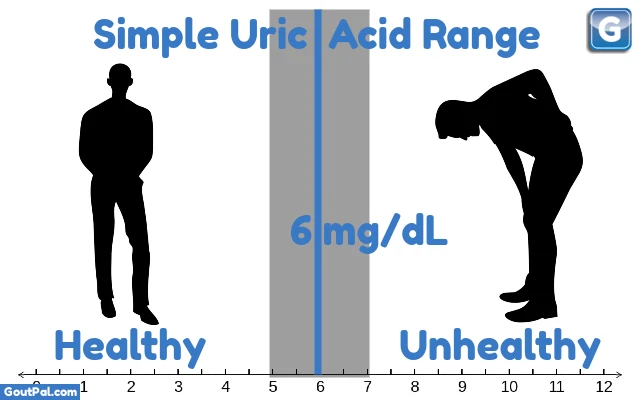This is my review of a normal uric acid range study. In which I will explain the key points for gout sufferers. So this is for people who are concerned about how normal uric acid ranges affects gout. Because it helps you discuss your normal uric acid concerns with health professionals. In the hope that you can support your doctor’s treatment plan with better uric acid targets.
Citation for Normal Range of Uric Acid
This is a GoutPal review of:
Desideri, G., G. Castaldo, A. Lombardi, M. Mussap, A. Testa, R. Pontremoli, L. Punzi, and C. Borghi. “Is it time to revise the normal range of serum uric acid levels.” Eur Rev Med Pharmacol Sci 18, no. 9 (2014): 1295-306.
At the time of writing, this study has been cited by 150 other studies.
Normal Range of Uric Acid Purpose
The purpose of this study is to present an alternative way of defining the normal range for uric acid in the blood.
it might be more appropriate to define the reference range of serum uric acid levels according to its physiological role and pathophysiological involvement in human diseases, rather than according to the distribution of its circulating levels in the general population
Jargon-free Abstract
In the jargon-free abstract I present the key points of the original abstract. Replacing jargon with terms more familiar to unqualified people interested in gout. Note that my selection of jargon terms might not match yours. So please ask in the feedback form near the end of the page if you need clarification.
- Background / Introduction
- The study explains how the incidence of gout is increasing globally. Also average levels of uric acid in the blood are rising. So the average American uric acid level is now higher than the maximum target set by gout treatment guidelines.
the mean serum uric acid levels in United States is increased from 3.4 mg/dL in 1920s to 6.25 mg/dL in 1970s
- Methods
- The study reviews evidence across several headings:
- Uric Acid and Muscles, Bones, and Connective Tissues (Musculoskeletal) Damage
- Uric Acid and Traditional Heart and Blood Vessels (Cardiovascular) Risk Factors
- Uric Acid and Cardiovascular Diseases
- Uric Acid and Brain Health
- Uric Acid and Kidney (Renal) Disease
- Results / Findings
-
- Gout is more widespread than the traditional view of classic gout flares.
- Modern imaging technology reveals damage in and around joints of people with high uric acid but without gout flares.
- There is evidence that high uric acid is linked to heart disease, kidney disease, and other metabolic disorders.
Original Abstract
The actual reference range of serum uric acid has been assessed according to its variations among healthy individuals. i.e. those without clinical evidence of gout. By this approach, serum uric acid values between 3.5 and 7.2 mg/dL in adult males and postmenopausal women and between 2.6 and 6.0 mg/dL in premenopausal women have been identified as normal in many countries. However, this definition of normal range of serum uric acid in the general population is inevitably influenced by what we consider as “normal”, since the absence of gout flares does not necessarily imply the absence of uric acid-related damage. Indeed, a growing body of evidence indicates that silent deposition of monosodium urate crystals as a result of hyperuricaemia may occur and lead to early destructive skeletal changes. In addition, a growing body of evidences demonstrates that uric acid might play a pathophysiological role in many “cardio-nephro-metabolic” disorders, which seems to be independent of the deposition of monosodium urate crystals, since it is evident also for serum uric acid concentrations below the saturation point for monosodium urate. Taken together, these findings strongly suggest to carefully reconsider the concept of “asymptomaticity” for chronic hyperuricemia and to consequently revise the normal range of serum uric acid levels also considering the progressive worldwide increase of circulating levels of uric acid, which could lead to a “shift to right” (i.e. toward higher values) of normal range. In the light of the new scientific knowledge on the pathophysiological role of uric acid in human disease, a threshold value
Normal Range of Uric Acid Conclusions
The normal range for uric acid in the blood is based on testing healthy people. Currently, this includes people with high uric acid and without traditional gout symptoms. But the normal uric acid range calculations should exclude people with 6 mg/dL or higher.
these findings strongly suggest to carefully reconsider the concept of “asymptomaticity” for chronic hyperuricemia and to consequently revise the normal range of serum uric acid levels. A threshold value for serum uric acid

Cited By
- Dangers of Normal Uric Acid
- Uric acid, is painless. But there are five ways it can turn painful. And dangers go beyond pain. Is uric acid dangerous to you? Stop 5 dangers of normal uric acid. 5 Ways Normal Uric Acid Is Dangerously Painful.
For email notifications when I publish more study reviews here, please subscribe to this website:
Subscribe to Free GoutPal Links
Subscription is free, and your email address is safe - I will never share it with anyone else. I use Gumroad to provide this service, as described at GoutPal Links Newsletter Service.
Leave Normal Range of Uric Acid to read Gout Library Home Page.
Normal Range of Uric Acid Vocabulary
-
cardiovascular
⇢ heart and blood vessels
-
hyperuricemia
⇢ high uric acid
-
MSU (MonoSodium Urate)
⇢ uric acid (usually crystals) bonded with sodium and water molecules.
-
musculoskeletal
⇢ muscles, bones, and connective tissues
-
nephro-
⇢ relating to kidneys (Greek)
-
renal
⇢ relating to kidneys (Latin)
-
serum
⇢ liquid part of the blood
Common Terms: cardiovascular, hyperuricemia, MSU (MonoSodium Urate), serum